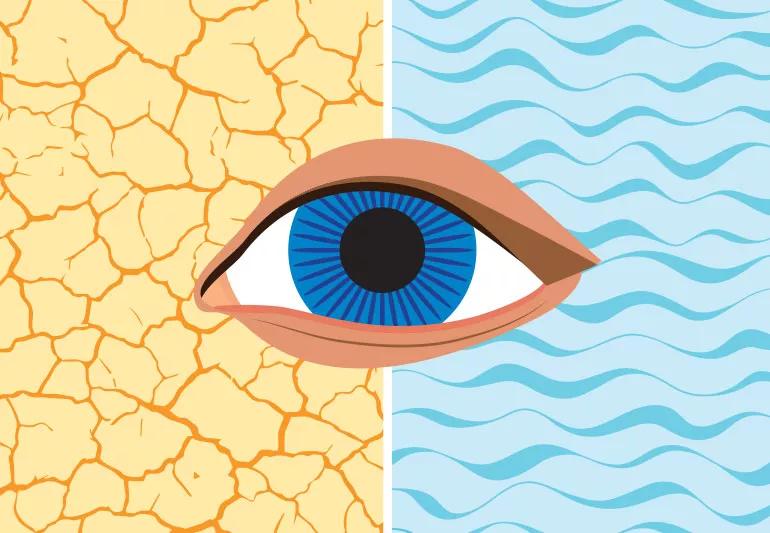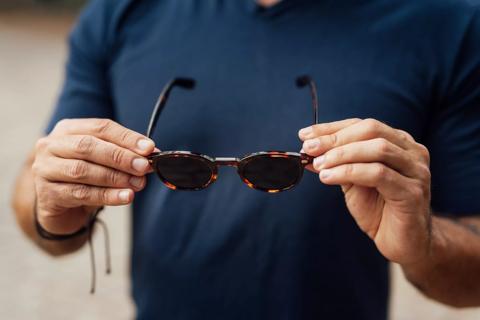Wet age-related macular degeneration is rarer and always advanced

If you or someone you know has been diagnosed with macular degeneration, you know there are a lot of terms thrown around. Even the names of the conditions are long and complex. Not to mention the implications on your life when you’re told you’re living with macular degeneration. It’s not surprising that you may feel confused, nervous and full of questions.
Advertisement
Cleveland Clinic is a non-profit academic medical center. Advertising on our site helps support our mission. We do not endorse non-Cleveland Clinic products or services. Policy
“It can be scary to be diagnosed with macular degeneration,” explains ophthalmologist and retina specialist Aleksandra Rachitskaya, MD. “A lot of people know someone who’s lost their vision from it, but it’s important to know that macular degeneration exists on a spectrum, and in many cases, we have treatments available to try to preserve your sight.”
But what exactly is age-related macular degeneration? What are the differences between the “wet” kind and the “dry” kind? And what does it all mean for your vision? Dr. Rachitskaya explains.
We know it’s a mouthful to say, so let’s start by breaking down what is meant by “age-related macular degeneration.”
Age-related means that your condition is related to aging — as opposed to other causes, like diabetes, injuries or infections. Typically, age-related macular degeneration is a condition that develops after age 50. Dr. Rachitskaya says it’s more common in people ages 70+.
Macular refers to your macula, a specific part of your eye. Your macula is an area in the center of your retina, which is the very back layer of your eyeball. Your macula is responsible for your central vision — that’s to say, your retina allows you to see figures and shapes that are right in front of you. Your macula allows you to see details in your central vision — things like letters on a page or the color of someone’s shirt. Central vision allows us to do things like see faces, read, work on the computer, knit and drive.
Advertisement
Degeneration means there’s damage to your macula. That damage doesn’t necessarily affect both of your eyes the same. One eye may not be affected or may be affected less than the other.
Macular degeneration comes in one of two forms: wet and dry.
| Dry age-related macular degeneration | Wet age-related macular degeneration | |
|---|---|---|
| Rarity | 90% of all cases of age-related macular degeneration. Advanced form of geographic atrophy is rare. | 10% of all cases of age-related macular degeneration. |
| Why it happens | Protein deposits (drusen) damage macula. | Abnormal blood vessels grow under the retina and cause swelling and bleeding. |
| Severity | May progress from no impact on your vision to a loss of central vision. Geographic atrophy is the most advanced form. | Always impacts central vision. |
| Treatments | Lifestyle changes, including vitamin supplements and diet may stop progression. New treatments can slow down the progression of geographic atrophy. | Consistent treatment with injection medication may stop or reverse vision loss. |
| Rarity | ||
| Dry age-related macular degeneration | ||
| 90% of all cases of age-related macular degeneration. Advanced form of geographic atrophy is rare. | ||
| Wet age-related macular degeneration | ||
| 10% of all cases of age-related macular degeneration. | ||
| Why it happens | ||
| Dry age-related macular degeneration | ||
| Protein deposits (drusen) damage macula. | ||
| Wet age-related macular degeneration | ||
| Abnormal blood vessels grow under the retina and cause swelling and bleeding. | ||
| Severity | ||
| Dry age-related macular degeneration | ||
| May progress from no impact on your vision to a loss of central vision. Geographic atrophy is the most advanced form. | ||
| Wet age-related macular degeneration | ||
| Always impacts central vision. | ||
| Treatments | ||
| Dry age-related macular degeneration | ||
| Lifestyle changes, including vitamin supplements and diet may stop progression. New treatments can slow down the progression of geographic atrophy. | ||
| Wet age-related macular degeneration | ||
| Consistent treatment with injection medication may stop or reverse vision loss. |
Yes. Some people may begin by having dry age-related macular degeneration that progresses into the wet kind. Dry macular degeneration can also progress to geographic atrophy.
Let’s take a closer look.
Dry age-related macular degeneration is the more common form of age-related macular degeneration. About 90% of people with age-related macular degeneration have the dry kind. Geographic atrophy is the advanced stage of dry age-related macular degeneration.
The dry condition develops when tiny protein deposits, called drusen, form in your macula.
Dry age-related macular degeneration develops in stages. In the early stage, your eye care provider will see changes to your macula, but you won’t experience any vision changes. In the intermediate stage, your vision may become slightly blurry. If your condition progresses to the advanced stage, the macula becomes thinned and you can lose your central vision altogether.
But not everyone with dry age-related macular degeneration will experience that progression.
“Some people can stay in an early stage of dry macular degeneration and not have significant vision changes. They may stay stable, even without getting treatment,” Dr. Rachitskaya explains.
There are steps your eye specialist may recommend to slow down the progression of dry age-related macular degeneration. That includes things like:
Wet age-related macular degeneration (also called exudative macular degeneration) is much less common than the dry type.
It happens when your body creates abnormal blood vessels under your retina in the macular region. Those blood vessels cause fluid accumulation and bleeding in the macula.
While dry age-related macular degeneration happens more gradually and in stages, wet age-related macular degeneration is always considered to be an advanced stage.
Although wet age-related macular degeneration is an advanced condition, there is hope. Dr. Rachitskaya says that anti-vascular endothelial growth factor (anti-VEGF) injections can control the growth of new blood vessels in your eyes. They’re not an all-out cure, but they’ve proven to be an effective treatment.
Advertisement
“Particularly when we catch the disease early, continued and consistent treatment can not only preserve vision, but in some cases can improve the vision of people with wet age-related macular degeneration,” she continues. “We have a lot of data showing that with treatment we’re often able to preserve vision and provide good vision and independence to our patients.”
As you age, it’s important to recognize any changes in your vision and to seek prompt medical care. But because macular degeneration can begin before you notice any issues, regular eye care is important.
“The earlier we can intervene, the better the chances are that we can catch eye conditions in their early stages when they are most treatable. So, it’s important to visit your eye provider every year and to make an appointment if you experience any new visual symptoms,” Dr. Rachitskaya advises.
Advertisement
Learn more about our editorial process.
Advertisement

Having a first-degree biological relative with this eye condition raises your risk, but other factors are at play, too

Preserving your social life and protecting your mental health are key to living well with vision loss

Start low-vision rehabilitation as soon as possible and see your retina specialist at least every six months

Getting connected to the right healthcare providers can make a big difference

Taking care of yourself helps you take care of your loved one

Installing grab bars and taping down area rugs may make navigating life with vision loss easier

Eating a balanced diet can help protect your eyes and may prevent AMD from progressing

They may help, but it depends on factors like the stage of your disease

Babies can get congested easily, but you can calm their cough by keeping them hydrated, using nasal drops and running a humidifier

Weight loss may cause loose, sagging skin and muscle loss to your rear

Several conditions, like vitiligo and fungal infection, can cause a loss of pigmentation, leading to white spots or patches on your skin